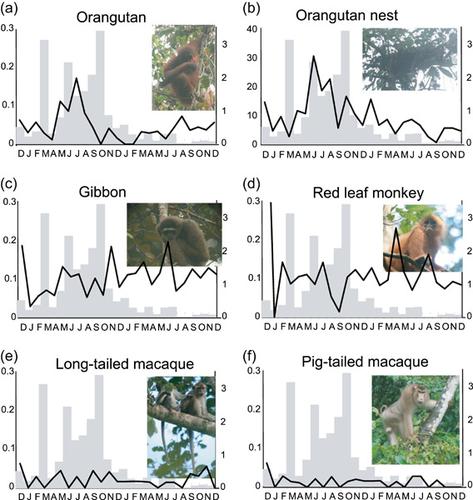当前位置:
X-MOL 学术
›
Am. J. Primatol.
›
论文详情
Our official English website, www.x-mol.net, welcomes your feedback! (Note: you will need to create a separate account there.)
Habitat use by a primate community in a lowland dipterocarp forest in Danum Valley, Borneo.
American Journal of Primatology ( IF 2.4 ) Pub Date : 2020-06-09 , DOI: 10.1002/ajp.23157 Goro Hanya 1 , Tomoko Kanamori 1, 2 , Noko Kuze 3 , Siew Te Wong 4 , Henry Bernard 5
American Journal of Primatology ( IF 2.4 ) Pub Date : 2020-06-09 , DOI: 10.1002/ajp.23157 Goro Hanya 1 , Tomoko Kanamori 1, 2 , Noko Kuze 3 , Siew Te Wong 4 , Henry Bernard 5
Affiliation

|
Knowledge of niche partitioning with respect to habitat is indispensable to understand the mechanism of coexistence of multiple species. Among primates, however, data are still deficient because repeated survey for a sufficiently long time, covering seasonal changes over a large area, is the only way to clarify habitat segregation within a seasonally fluctuating environment. Southeast Asia is particularly interesting because of the supra‐annual, highly unpredictable seasonality in fruiting known as mast fruiting. We conducted repeated route census, habitat monitoring, and group tracking for 25 months in two study sites (ca. 10 km apart) in the largely primary lowland dipterocarp forest of the Danum Valley Conservation Area, eastern Sabah, northern Borneo, Malaysia. The five species of diurnal primates (Bornean orangutan Pongo pygmaeus , Müeller's gibbon Hylobates muelleri , red leaf monkey Presbytis rubicunda , long‐tailed macaque Macaca fascicularis , and southern pig‐tailed macaque M. nemestrina ) did not show horizontal spatial segregation. Red leaf monkeys showed preferences for places with short tree height, but their distribution was not confined to such places. In response to the fruiting peak observed once during the study period, orangutans increased their numbers simultaneously in the two study sites. The average tree height used by the five species was different, but their range overlapped substantially. Compared with other primate communities, the lack of horizontal spatial segregation and the suggested long‐distance movement of orangutans seem to be unique characteristics in Borneo, although the use of different forest strata is a widespread phenomenon among primate communities throughout the world.
中文翻译:

婆罗洲丹努姆谷低地龙脑香林中的灵长类动物群落生境的使用。
关于生境的生态位分配的知识对于理解多种物种共存的机制是必不可少的。然而,在灵长类动物中,数据仍然不足,因为在足够大的时间内进行反复调查(涵盖大面积的季节性变化)是澄清季节性波动环境中生境隔离的唯一方法。东南亚之所以特别有趣,是因为该季节的结实季节(称为肥大结实)是极为不可预测的季节性。我们在马来西亚婆罗洲北部沙巴州丹努姆谷自然保护区的主要原生低地龙脑森林的两个研究地点(相距约10公里)中进行了重复的路线普查,栖息地监测和小组追踪,为期25个月。昼夜灵长类动物五种(婆罗洲猩猩Pongo pygmaeus,Müeller的长臂猿Hylobates muelleri,红叶猴Presbytis rubicunda,长尾猕猴Macaca fascicularis和南部猪尾猕猴M. nemestrina)未显示水平空间隔离。红叶猴对树高较短的地方表现出偏爱,但它们的分布并不局限于这些地方。为了响应研究期间一次观察到的结果高峰,猩猩在两个研究地点同时增加了它们的数量。这五个物种使用的平均树高不同,但它们的范围基本重叠。与其他灵长类动物群落相比,缺乏婆罗洲的水平空间隔离和猩猩的长距离运动似乎是婆罗洲的独特特征,尽管在世界各地的灵长类动物群落中广泛使用不同的森林地层。
更新日期:2020-07-24
中文翻译:

婆罗洲丹努姆谷低地龙脑香林中的灵长类动物群落生境的使用。
关于生境的生态位分配的知识对于理解多种物种共存的机制是必不可少的。然而,在灵长类动物中,数据仍然不足,因为在足够大的时间内进行反复调查(涵盖大面积的季节性变化)是澄清季节性波动环境中生境隔离的唯一方法。东南亚之所以特别有趣,是因为该季节的结实季节(称为肥大结实)是极为不可预测的季节性。我们在马来西亚婆罗洲北部沙巴州丹努姆谷自然保护区的主要原生低地龙脑森林的两个研究地点(相距约10公里)中进行了重复的路线普查,栖息地监测和小组追踪,为期25个月。昼夜灵长类动物五种(婆罗洲猩猩Pongo pygmaeus,Müeller的长臂猿Hylobates muelleri,红叶猴Presbytis rubicunda,长尾猕猴Macaca fascicularis和南部猪尾猕猴M. nemestrina)未显示水平空间隔离。红叶猴对树高较短的地方表现出偏爱,但它们的分布并不局限于这些地方。为了响应研究期间一次观察到的结果高峰,猩猩在两个研究地点同时增加了它们的数量。这五个物种使用的平均树高不同,但它们的范围基本重叠。与其他灵长类动物群落相比,缺乏婆罗洲的水平空间隔离和猩猩的长距离运动似乎是婆罗洲的独特特征,尽管在世界各地的灵长类动物群落中广泛使用不同的森林地层。



























 京公网安备 11010802027423号
京公网安备 11010802027423号